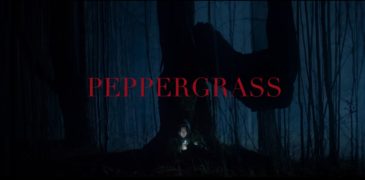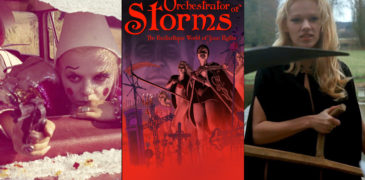Oh, the level of alleged and legitimate prestige Dreamcatcher boasts – directed and co-scripted by Lawrence Kasdan (Body Heat) with the help of William Goldman (Marathon Man) from a novel by Stephen King and featuring Morgan Freeman, Thomas Jane, Damian Lewis, Timothy Olyphant and Jason Lee. The early aughts were a glorious time to be Tom Jane. He’d headline another King adaptation a few years later, and the following year would be christened The Punisher in a Marvel reboot.
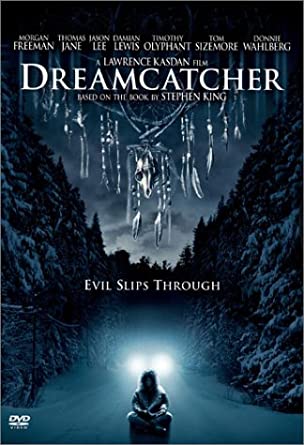
2003 was also a time like this when men (not a single woman in the main cast) could indulge their worst impulses. If Damian Lewis wanted to spend half the movie doing a hammy Malcolm Mcdowell impression, by gum, he was going to do it. If Lawrence Kasdan wanted to put The Thing in The Big Chill, no one was going to stop him.
At least King could not be entirely blamed. In this case, it was the drugs talking. King has gone on record stating that much of the writing was done under the influence of the Oxycontin he was prescribed after being nearly fatally hit by a van. There’s something crazier about Dreamcatcher, though, than just a drug haze. For all involved, it’s best to explain Dreamcatcher’s story in one breath. For one, it might be funnier. It’s also a lot to handle, and easier to take at face value if you don’t have time to question it:
Four psychic friends – Jonesy (Lewis), Henry (Jane), Pete (Olyphant) and Beaver (Lee) – reunite for their annual hunting trip in the Maine woods at the same time as a nearby Thing-like invasion. Though a military operation led by a mad Colonel (Freeman) is largely successful early on, Jonesy is infected by the host and heads for populated areas. But the friends’ mentally challenged (also psychic) childhood pal Dudditz (Donnie Wahlberg) holds the key to stopping the invasion.
The reunion is Kasdan’s excuse to lightly remind audiences of The Big Chill. The guys gather around the table and reminisce as a pop song plays and talk about women they never slept with. Chill is a film enjoyed by exactly one generation of people, or rather a very specific subset of that generation. It pines for the glory of idealistic college days, specifically the radical 60s, but as Dave Kehr described in Chicago magazine, “manufactures complacency.”
It’s been a long time since Chill, and these characters aren’t the boomers-come-yuppies that Kasdan knew. There’s no relatable conversation. Their pop culture is a mix of Chillers, given their love of Roy Orbison’s “Blue Bayou” and late period 80s films that maybe would find a place in a Gen Xers heart – dramas like Promised Land, for which they misremember name of the lead, “Reefer Sutherland” (ha? He had a hit show at the time, boomer).
Their made-up, would-be catchphrases would probably be offensive if they weren’t so downright bemusing. It’s like watching aliens pretend to be human before any in-film invasion. Perhaps not being from Maine creates the dissonance, but I doubt “Bitch in a buzzsaw” gets much play there. We understand the difference between a “fuckeree” and a “fuckerow” about as well as we know how the three seashells work in Demolition Man.
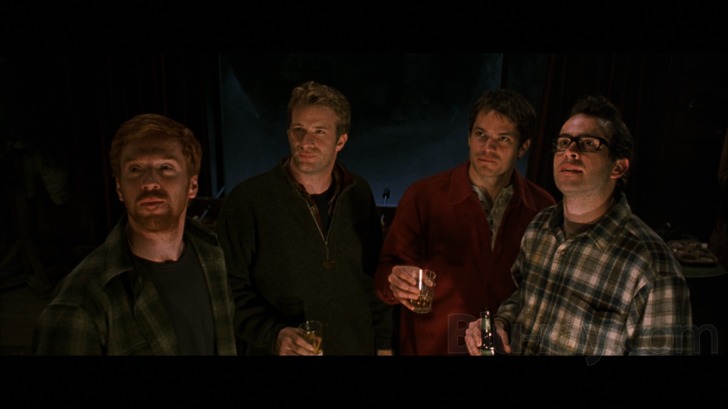
It helps to be from 2003, knee-deep in the ephemera of the era. Dreamcatcher came out on March 21, two months before my high school graduation.
Maxim’s online edition was frequently on students’ browsers. 50 Cent’s “In Da Club” played the prom. Arnold Schwarzenegger successfully unseated Governor Gray Davis in a recall election in California. Lance Armstrong won his fifth Tour De France. Roy Moore was removed from Alabama federal court for refusing to remove the Ten Commandments. The day before the movie hit theatres, George W. Bush unlawfully invaded Iraq on false pretenses. And the best-selling book in the country was not anything King had written, but noted homophobe and all-around bigot Michael Savage’s Savage Nation.
Guys were fucking entitled. It was perhaps that same sense of entitlement that gave Kasdan a budget for a 136-minute sci-fi/horror remake of his most revered/reviled work. It’s worth noting that the horror community did have its own response to The Big Chill one year previous. Screenwriter Josh Olson has often called his feature-length directorial debut Infested a loose, vitriolic remake of the film.
Dreamcatcher gets bugnuts when the banter scene introduces a major plot point. Much of the film is spent inside Jonsey’s “memory warehouse”, a Bad Writer idea clumsily introduced in conversation. It’s…exactly what it sounds like – a dusty library crowded with filing cabinets loaded with his memories inside his head. After the alien takes control of him, it becomes a setpiece. Jonesy must gather some private files on Dudditz and hide them in a secret room it can’t access. Oxycontin must be some ride. It gets dumber. Guns become psychic cell phones, and Dudditz is also an alien.
We’ve yet to talk about the shitweasels. Shitweasels, both in the novel and the film, are the term for the alien’s chest bursters, this time exploding out of your anus. They’re phallic worms with razor-sharp teeth that have a tendency to also go for the straight for the male genitalia. If Dreamcatcher is remembered for anything, it’s this: A sub-par CGI ripoff of Cronenbergian terror that looks recycled from the set of The Faculty.
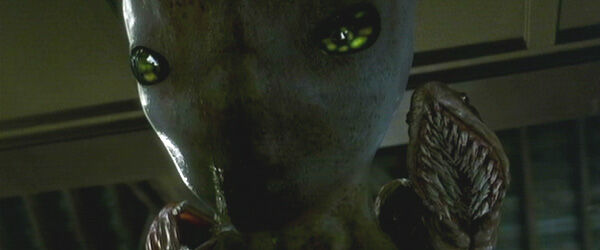
Dreamcatcher often feels like too many different movies to count, but the patchwork is shoddy. There are overtones of Aliens, The Thing, Independence Day, The Big Chill, Stand By Me, and even a hint of Misery. It’d be nice if the impressive ensemble helped, but they were all off doing their own thing, often in a different film. After Lewis is taken over by the alien, his aforementioned McDowell is nothing but an odd distraction. The rest appear to be phoning it in or collecting early paychecks (Olyphant suffers the worst of the bros-in-the-woods script).
Dreamcatcher does at least know from where it borrows. The alien’s red, War of the Worlds-esque fungus is called Ripley. Freeman’s madman is Colonel Curtis, a play on Brando’s Kurtz in Apocalypse Now. These references only inspire ire, that Kasdan had the gall to compare.
I can’t say I hated Dreamcatcher. There’s fun to be had in its excesses. I often think about what the writing process must have been like. Surely, tripping on rims is going to affect your thinking, but King was also very nearly killed. New research has shown that near-death experiences actually are akin to a replay of your greatest hits. I like to imagine King, while in a hospital bed, started reliving his best moments in his memory warehouse writing It and Misery and The Body and began recording them high on greenies. One day, his publisher stops in to visit while he’s asleep and in hopes the pages might wind up on the NYTimes list…
It was the early aughts. F*** it.
This article was originally written by Kenny Hedges for Grimoire of Horror.
More Film Reviews
In the middle of a pandemic, times are hard for Eula Baek and the restaurant she inherited from her grandfather. A plan to get some rare truffles to help raise… Fans of the horror are very much aware of the amount of subgenres that have been birthed out of the general moniker of being called horror. However, out of all… Jean Rollin was a French director of fantastique films whose films remained obscure throughout most of his career. Thanks to longtime admirers, his haunting and poetic visions are seducing a… I had the great fortune of viewing the documentary Satoshi Kon: The Illusionist (2021) at this years’ Nightstream horror film festival. As a longtime fan of his work it turned out… Director Koji Shiraishi takes a dip into cryptozoology in Senritsu Kaiki File Kowasugi! File 03: Legend of a Human-Eating Kappa (shortened to File 03). In this third installment in the… Despite being one of Japan’s biggest film studios throughout the late 40s and 50s during the golden age of Japanese cinema, Daiei were struggling by the mid-60s and had to…Peppergrass (2021) Film Review – Truffles To Die For
30 Best Horror Comedy Films – From Classic to Cult
Orchestrator of Storms: The Fantastique World of Jean Rollin (2022) Film Review – An Excellent Introduction to the Artistry of an Obscure Filmmaker
Satoshi Kon: The Illusionist (2021) Film Review: A Short Life with Immeasurable Impact
Senritsu Kaiki File Kowasugi! File 03: Legend of a Human-Eating Kappa (2013) Film Review- Now it’s a cryptid!
Kanto Woman Yakuza (1968) Film Review – A Moody Neo-Noir Masterclass
